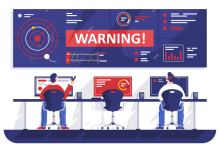
As I travel and speak with contact center leaders around the world, a very vocal set of customers tell me that their call recording and coaching programs have gone stale. Trapped under heavy versions of software applications from the likes of NICE and Verint, these contact center leaders feel stifled by their task to engage employees, drive change and transform their shifting workforce. What can be done? What steps can make coaching fresh and fun? Is upgrading an old legacy system the right option? I’d like to share 4 fresh innovations that are helping organizations answer these questions and revive stale coaching programs.
1. Think Big
One of the biggest struggles for contact centers considering any new innovations in Workforce Optimization is that most offerings in the market today are simply an independent, stand-alone, mix-and-match of applications acquired through acquisition (i.e., WFM, agent guidance, surveys, speech analytics, etc.). While each of these solutions have their own return on investment, look for solutions that allow you to try to license these components inside your coaching program without a heavy upgrade. Speech analytics, on-screen guidance, WFM and e-learning should be native to your platform, not independent of coaching.
2. Provide Guidance
Why coach and repeat when you can guide and succeed? On-screen guidance for employees is transforming the old script methods of the past. If you are evaluating this today, you’ll know that agent automation has developed a bad reputation as being complex and hard to deploy. Look for tools that are native to coaching and screen recording so you can coach to behaviors and then monitor usage.
3. Drive Coaching Based on Analytics
Customers have leveraged speech analytics for over a decade now and still struggle to use it with coaching because analytics is not part of the coaching process. Look for tools that drive evaluation goals to supervisors and QM based on analytics results. Target coaching based on factors such as topic and sentiment. Make your employees feel engaged, rather than cherry-picked from a playlist of bad calls.
4. Ask and Listen
Finally, balance your collection of customer feedback by asking good survey questions and listening for customer feedback through speech analytics. In both methods, tie the results to coaching. Initiate surveys from the contact center that link back to the employee and can become a native part of the quality monitoring process. Let speech analytics guide evaluation goals—frequency and coaching topic.
In late 2016, Forrester released their first ever Forrester Wave™: Workforce Optimization Suites report and researchers scoured the WFO market to understand more than vendor noise. They looked closely at this “staleness” problem and what contact center teams are doing. What problems they’re solving with WFO solutions. What the actual leaders (like you) believe are most important in delivering successful customer experiences. When you strip away all of that noise in the market, Forrester found that organizations wanted a partner in this struggle. I invite you to download your free copy of this market evaluation from Forrester and learn more about how to invigorate your coaching program with the energy, innovation and excitement.
Download a PDF of this article.




